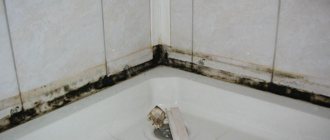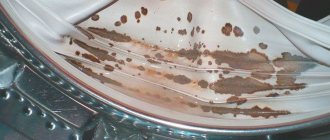A fungus is a type of microorganism that multiplies especially actively in high humidity. In the bathhouse, the problem of mold is especially relevant, since there are all the conditions for the rapid and active growth of pathogen spores.
The fungus appears in the form of a black coating or inclusions, which primarily affect the floor and ceiling, after which it spreads to the benches and dressing room.
Fighting mold is quite difficult, but there are a number of methods that have been tested by time and the experience of bathhouse attendants from all over the country. Let's figure out how to solve an existing problem and what needs to be done to prevent the formation of fungus in the bathhouse.
Why is it so important to fight fungus?
Fungus is a frequent companion of a bathhouse, and no matter how carefully the treatment is carried out, absolutely everyone faces this problem. It is impossible to ensure sterile conditions, and the fungus, as we know, reproduces by spores that easily move with air flow and settle on new surfaces.
This “volatile” property makes mold so dangerous for humans, since during bath procedures there is every chance that microspores will penetrate the respiratory system or onto the skin, provoking the development of various diseases. That is why the fungus must and can be combated using various available methods.
Here are some more reasons why mold needs to be removed:
Unpleasant aroma
If the bathhouse smells damp and musty, you can be sure that the wood is infected with fungi that produce spores that are hazardous to health.
Wood destruction
Pathogens feed on wood cells, destroying it and disrupting its natural integrity. The bathhouse begins to actively rot, which “smacks” in the literal sense of the word of repairs and impressive financial expenses.
Development of an allergic reaction
The bath should heal, not cripple. Otherwise, what is the point of visiting this establishment if it is simply unsafe for health? Moreover, this danger is not only for the health of those who steam there, but also for those who clean or work there.
Health comes first, and while a rotting floor can be replaced, such a trick is impossible with lungs. The absence of mold is the key to proper and favorable vaping, which will bring maximum benefits to the body.
Advice! If you come to the bathhouse, and the steam room has an unpleasant aroma of dampness, which can be found in the forest after rain, it is best not to steam in such an establishment. No amount of steam, as many unscrupulous bath attendants say, is capable of completely destroying the fungus (otherwise there would be no problem a priori). There are spores in wood, and they easily float in the air, penetrating the respiratory system.
List of basic recommendations
- To build a bathhouse, try to use wood cut in winter. In the fall you can lay the foundation, and in the spring you can install a bathhouse;
- Check the wood carefully. If you find characteristic signs, even if there is a healthy one nearby, do not take it. She is already affected and the appearance of spots is a matter of time;
We invite you to read Finishing a stove with tiles with your own hands │ How to stick tiles on a stove with your own hands
If it is possible to use a moisture meter when choosing, great.
- Be sure to provide “vents” for natural ventilation of the underground, attic and in the ribs of the frame;
- Properly arrange the waterproofing of the foundation and supporting structures (this also applies to vapor barriers);
- Provide effective exhaust ventilation;
- Treat the surfaces of the bathhouse with an antiseptic;
- Insulate freezing external walls, slopes and ceilings;
- If double-glazed windows are installed in the bathhouse windows, insert ventilation valves (for ventilation).
- Promptly repair leaking plumbing fixtures and communications;
- Check the cleanliness of the ventilation ducts and the functionality of forced ventilation;
- If the bathhouse has the possibility of constant heating, provide it sufficiently;
- Try not to leave wet fabrics (towels, sheets, etc.) in an unheated bathhouse (for example, in a country house), and always straighten plastic shower screens (curtains) for complete drying;
Mold absolutely loves dirt. Therefore, wash the bathhouse regularly and thoroughly. Regular rinsing with water is not entirely effective. There are special household hygiene products for baths and saunas on sale. For example, Finnish cleaning solution HARVIA Sauna, Tolu and others. They are applied with a soft sponge and washed off with warm water.
Even before construction it is worth considering:
It is better to use wood cut down in winter as a material for constructing a bathhouse.
In the autumn, it is better to limit yourself to laying the foundation, and with the arrival of spring, build the bathhouse itself. Pay special attention to wood quality control. Try not to take even healthy wood if it grows next to a defective tree
We can assume that it is also infected, and it is only a matter of time before it becomes stained and begins to deteriorate.
It is better if you have a moisture meter at hand - it will greatly simplify the process of choosing the right tree.
When building a bathhouse, remember:
- Be sure to equip the underground, attic and frame ribs with ventilation.
- Lay high-quality vapor and moisture insulation on the foundation and supporting structures.
- Consider and install an effective ventilation system.
- Treat all surfaces in bath rooms with an antiseptic substance.
- Insulate slopes, ceilings and external walls to prevent freezing.
- If the bathhouse has double-glazed windows, then it is worth installing valves for ventilation.
During operation, do not forget about these recommendations:
- Try to repair damaged plumbing and communications in a timely manner.
- Clean the ventilation ducts in a timely manner and also check the functionality of the forced ventilation.
- If it is possible to carry out constant heating, this will have a positive effect on the bathhouse, since it will prevent the appearance of mold, and the structure will last longer.
- Do not leave any damp fabrics in an unheated bath; always allow them to dry completely.
Reasons for the development of mold and the most problematic places in the bathhouse
In order for mold to form and activate its activity, three key conditions are needed: the absence of ultraviolet radiation (in the form of natural light), humidity above 75%, and constant heat. All this is in the steam room, where you can find black inclusions, plaque or even already deformed boards on the panels below.
This may not look attractive, but in reality there are many more reasons:
Lack of ventilation - a steam room is usually built without ventilation ducts, since a significant portion of the heat will escape through them, and fuel consumption will increase accordingly. This leads to stagnation of humid air, which helps maintain a microclimate favorable to mold.
There is no natural light - the absence of windows for similar reasons also has a beneficial effect on the fungus. Ultraviolet light is the first and most important enemy of mold, which destroys cell membranes and completely stops the life cycle of pathogens.
Violation of thermal insulation rules when mistakes are made during insulation of the bath, which subsequently lead to the formation of condensation. The latter, in turn, increases the humidity of the bath even when it is not in use.
Places most likely to develop fungus are:
shower room
dressing room
steam room floor and ceiling
joints of logs where there are gaps
shelves and places for drying brooms
It is important to understand that not one of the materials used in the construction of a bathhouse is protected from fungal attack. But in wood, which is a natural environment, it develops much faster.
Naturally, it is impossible to create absolute sterility, so the fungus was, is and will always be. But it is important to control its population, for which special means and improvised methods are used.
Advice! If you think that fungus can be removed in one treatment, then you are mistaken. Mold may not be visible visually, but continues to actively grow at the micro level, posing a serious danger to life. Therefore, it is important to remember 3 important points: treatment, prevention, ventilation. This is the only way to win an unequal battle with the “black enemy”, which sooner or later will make itself known.
Available means
In pursuit of environmental friendliness, many strive to treat baths with the safest possible means, since everyone understands that chemicals are easily absorbed by wood, and when heated, toxic fumes are released into the air. As an alternative, you can use some products that everyone has in their home.
Soda and vinegar
A sudden change from an alkaline to an acidic environment leads to the death of mold, so be sure to try this product before using more aggressive chemicals.
The sequence of actions is as follows:
- Dry the damaged surface well; you can use a hair dryer if you need to do it quickly.
- Mix a tablespoon of baking soda with water to form a paste. Apply it to the damaged surface and leave for 10 minutes.
- Pour vinegar into a spray bottle and spray on selected areas.
- Remove the resulting foam using a damp cloth.
- Repeat the procedure several times, then dry and ventilate the room well.
Vinegar perfectly removes odors and evaporates quickly enough, leaving behind freshness. By reacting with soda, foam is formed, which penetrates deep enough into the wood and kills bacteria from the inside.
Hydrogen peroxide
The product is used when large areas need to be quickly treated. Just pour it into a spray bottle and go over all surfaces.
Peroxide is perfectly absorbed by wood and destroys putrefactive bacteria. It can be used not only to combat mold, but also to prevent its active development.
The product does not have an aggressive odor and does not destroy surfaces, be it wood, plastic or tiles. When vaping, no toxic substances are released into the air.
However, there is one important nuance: after applying the product, it is important to ventilate the room well. To do this, you can equip forced ventilation or use a fan.
Tea tree essential oil
This oil has a pronounced antiseptic effect, but its beneficial properties for a bath do not end there:
- It is well absorbed, creating an oil film on the surface that prevents water from penetrating into the wood.
- Destroys harmful bacteria, preventing them from spreading inside the tree.
- Creates a pleasant aroma in the steam room, which has a healing effect on the body.
- It has a prolonged effect and protects the tree for several months, preventing active decay processes.
Features of using this tool are as follows:
- Oil should only be applied to a previously cleaned and dried surface.
- The most convenient way to do this is with a sponge.
- There is no need to rinse off tea tree essential oil.
It is best to do spot treatments, since the product, when applied over large areas, can provoke the release of a persistent aroma, which, in the absence of ventilation, can cause a headache or cough.
Means for combating severe mold outbreaks
If there is particularly serious contamination in any part of the bathhouse, you need to:
- Remove everything that comes off easily. It is better to do this with a spatula if the work is done on wood surfaces. The cleaned substrate should be placed in a bag, then taken out of the living area and burned.
- Treat with aggressive components that will kill the fungus.
- Be sure to dry the surface and treat it with special impregnations for baths, which penetrate deeply into the wood and prevent moisture absorption.
The following improvised means will help remove black plaque:
- Citric acid + baking soda + dishwashing detergent - take all components in equal proportions, apply to the surface, leave for 20 minutes, rinse with water.
- Ammonia - use a brush to apply the product to the prepared surface and let it absorb. Work should be carried out in a respirator, ensuring good ventilation.
- Washing powder – mix with water and apply to affected areas. Let it soak in for 20-30 minutes, then rinse with water.
Remember that the treatment will have to be performed several times, and at the end you need to ventilate the area being treated well.
Will bleach help?
Often, expert advice indicates the effectiveness of using White with a chlorine composition to combat mold.
Naturally, there will be a result, and it will not be long in coming, if not for one big BUT. Working with bleach in a relatively closed room is very harmful to health; moreover, chlorine easily penetrates wood and evaporates when the temperature in the bathhouse rises.
Expert opinion
Lovkachev Boris Petrovich
Bath master who knows everything about steaming
It cannot be said that this method is safe and environmentally friendly. Cleaning a tiled floor in a steam room is one thing, but treating wood that shows signs of integrity damage due to fungus is more harmful than beneficial.
It is especially dangerous when inexperienced bath attendants, in pursuit of savings (a bottle of Whiteness costs around 28 rubles), manage to do the treatment using a spray bottle. Chlorine particles quickly penetrate the lungs, no matter how good the respirator is. It is better to familiarize yourself with the consequences of such an impact, but this is not very pleasant.
If you treat the surface pointwise, where the lesions are really large, it is possible, but for a complete treatment of the bath such a product is definitely not suitable.
Why is it better not to use an abrasive brush?
What is the most convenient way to apply the product to the surface and remove mold? Of course, with a brush, but few people think that it is better not to use such a “helper”.
Nelly Sadykova, who has been working as a bathhouse attendant for decades, made an interesting observation, which can be explained from a scientific point of view: if you clean a bathhouse with a brush, even without a cleaning agent, the fungus increases, but if you simply treat it and rinse it off with a stream of water, the result will be much better.
Let's figure out whether a brush is so harmful in cleaning a bathhouse from mold.
So, mold penetrates well into the pores of the wood, making it looser. This is understandable, but what is the fault of the brush? It’s simple: when we actively rub the damaged surface with it, a layer of wood is also removed along with the black coating, but this is not as scary as the fact that thin fibers make deep scratches in the wood, introducing spores of the same mold there.
As a result, it turns out that the brush acts as a carrier of “black infection”, and it seems to us that it more thoroughly removes the hated plaque.
Now let's remember how often the brush itself is treated and with what exactly? Running water with powder or detergent? But this is not enough to destroy those spores that thrive between the bristles. They will definitely end up on the wood upon subsequent contact, so such “monkey work” is a waste of time and effort.
It becomes clear that if you simply apply the product using the same sponge, let it sit for a certain time and rinse with water, the concentration of mold fungi will be much lower. Naturally, the procedure will have to be repeated, and more than once, but this approach will protect you from the main thing - the spores will not penetrate deeper, which is facilitated by the brush.
Alternatively, if there is a lot of plaque and the sponge cannot cope with it, you can use a regular construction spatula. It helps to clean off the dead layer of wood, but does not provoke the spread of spores into its deeper layers.
Let everyone draw their own conclusions, but be sure to try it as an experiment.
Where does it appear?
Aspergillus is a fairly unpretentious resident, which makes it almost ubiquitous. However, there are surfaces on which the appearance and active proliferation of fungus is most likely. There are several of them.
Plastic. PVC windows store heat, have a high degree of sound insulation and at the same time are excellent for the life of black mold (moisture does not evaporate).
Drywall. The material is convenient and popular in construction, but it absorbs moisture, which does not evaporate.
It is important to follow the installation technology here: slabs that are not completely dried will become a source of mold.
Concrete. Most often these are floors (floors, walls)
If designers or builders make mistakes, the joints between walls, especially corners, are exposed to precipitation and cold.
Technique. These are appliances that come into contact with moisture: refrigerator, washing machine, split system/air conditioner, air humidifiers. If these devices are used incorrectly, there is a possibility that black mold will settle there too. It is advisable to keep the equipment dry; wipe wet parts often.
Wardrobe items. This will happen if the laundry is stored in sealed boxes or damp cabinets. Most often, we simply break the rule of dryness: under no circumstances should we put away things that are not completely dried!
Treatment with chemicals
If the bathhouse is used quite often and there is no opportunity to “play” with the means at hand, professionals come to the rescue. Their composition is more than aggressive for the fungus, but moderately toxic for humans. That is, if you follow all the rules of use set forth by the manufacturer, you can protect yourself from negative impacts.
The leading positions are occupied by the following funds:
"Fongifluid"
The liquid product should be poured into a convenient container and applied to surfaces using a brush or roller. Leave for 5-6 days, after which you should rinse off the product with water and dry the room well.
"Stop-Mold" Olympus
The composition is applied to the prepared area of wood and left until completely absorbed. Doesn't need washing. Works well against various types of mold.
"Homeenpoisto"
The product is diluted in water in a ratio of 1:3 and applied to the surface using a sponge or brush. Allow to absorb and then rinse with water.
Note ! Most disinfectants are highly toxic. Wear a respirator, gloves and protective clothing, and follow all recommendations given by the manufacturer on the packaging.
It is not recommended to use chemicals more often than stated by the manufacturer. Toxic substances can remain active for quite a long time, and with increasing concentrations they can have a negative effect on the body.
Diet for oral candidiasis
Dietary nutrition for oral candidiasis is an important part of therapy. Consumption of sweet, bakery, fatty, sour, smoked and spicy foods can provoke candidiasis and its relapses, as well as cause irritation of the mucous membranes, aggravating symptoms and pain in the mouth. It is recommended to consume only semi-liquid foods at moderate temperatures.
For a period of 3 months to a year, you should avoid consuming the following products:
- Confectionery and sweets;
- Products containing yeast;
- Sweet fruits;
- Coffee Tea;
- Mushrooms;
- Sweet drinks with gas;
- Mayonnaise, ketchup, spices;
- Smoked meats, fatty fish and meats;
- Alcohol.
Experts recommend consuming the following foods for candidiasis:
- Baking without yeast;
- Cereals;
- Dairy products;
- Greens and vegetables, the best option is carrots and garlic;
- Herbal teas, natural juices;
- Flaxseed, coconut and olive oils;
- Lean fish, lean meat, liver;
- Nuts and seeds;
- Unsweetened fruits, lingonberries, cranberries, blueberries.
Such a diet will not eliminate aggravated candidiasis, but will speed up the patient’s recovery.
High pressure washer: all the pros and cons
Those who are familiar with the operation of log buildings sooner or later have to resort to high-pressure washers, which allow them to clean the surface of fungus and moss without any detergents or cleaning agents.
This approach is also appropriate for bath treatment, but not everything is so simple.
The advantages of cleaning a sauna from fungus using a jet of water under pressure are::
- A jet of water under pressure removes all contaminants, including soot near the stove and coals.
- There is no need to use chemical cleaning products that are harmful to health.
- The work is carried out very quickly with minimal effort.
- Water penetrates into hard-to-reach places where it is impossible to reach with a sponge.
- The space between the boards is well cleaned.
- The wood takes on a lighter shade.
- A jet of water under pressure removes dirt and mold as quickly as possible, so that moisture does not have time to be absorbed into the deeper layers of wood.
The advantages of the method are obvious.
It is not necessary to own a pressure washer for personal use, as many cleaning companies can offer them for rent.
By the way, these same organizations will be happy to help clean the bathhouse from fungus and mold, so you don’t have to worry at all and entrust the work to professionals.
As for the other side of the coin, and there is one, opinions are very contradictory:
- Firstly , a jet of water under pressure can not only clean out dirt, but also literally “remove” the protective layer of wood, making the sauna lining more vulnerable to fungus. You can solve the issue by manually adjusting the pressure and treating the bath in a more gentle mode.
- Secondly , along with the water, the fungus is washed out and flows onto the shelves and floor. Particularly affected areas will have to be treated first using special products.
- And the most important thing is the cost of such a miracle machine. It's good if you already have it. If not, you will have to rent or buy your own. As for savings, the question is ambiguous, because there will also be costs for cleaning products.
Conclusion
A clean, ventilated room is the key to good rest
Of course, when deciding how to remove mold, you first need to think about the fact that it is easier to prevent its appearance than to remove it after it appears. Simply rinsing will not remove dirt, so you need to wash the sauna regularly and thoroughly. In addition, periodically treat with preventative agents.
Our portal is ready to provide additional information on this issue, which is also contained in the proposed photos and videos in this article.
Did you like the article? Subscribe to our Yandex.Zen channel
Prevention measures and important points
For those who are constantly upset when they see fungus in the bathhouse, you can exhale. No matter how responsible you are, fungus will always appear on surfaces with high humidity.
There is no remedy that would solve this problem once and for all, but if you follow the following recommendations, you can still avoid massive damage to wood:
- Organize a hood - there are many ways to do it correctly. The steam room should dry thoroughly after each use.
- Reduce the humidity, increase the temperature - when the steaming is over, you need to remove the water sources, then heat the stove and let it cool in natural conditions. Dry air will kill the fungus and help the wood dry out completely.
- Don’t be shy about UV lamps - the method may be outdated, but it works perfectly in the absence of a window in the bathhouse. Turn on the lamp for 20-30 minutes, then ventilate the room well.
- Monitor condensation - most often it appears when there is a sudden change in room temperature, when the thermal insulation in the bathhouse is not done correctly.
- Carry out preventive treatment at least once a month using various means.
- Do not leave wet objects in the bathhouse, as they will become a source of increased humidity, which the fungus loves so much.
If the first signs of mold appear, there are black or green spots on the wood, and there is a persistent unpleasant aroma of dampness in the steam room, then the treatment must be carried out unscheduled.
How to consolidate the result
Any efforts to treat mold on the lining in a bathhouse, as described above, may be in vain if the cause of the fungus is not eliminated. Preventive measures include:
- Proper ventilation in the bathhouse.
- Mandatory installation of hydro and vapor barrier materials under the lining.
- Regular heating during the cold season.
- Purchase of high-quality, industrially dried lining.
- Treatment of lamellas with antiseptic solutions before installation.
5/5 — (100 votes)
FAQ
They advised me to clean off the mold using a metal brush attachment on a screwdriver. Everything cleared up very well, but the situation repeated itself after a few months. What to do?
The brush, especially a metal one, damaged the wood fibers, where the fungal spores got trapped. It will be quite difficult to remove them, but in this case it is better to immediately use special means for treating baths, and also find the reason why the fungus is developing in this particular place.
Is it possible to clean a sauna with toothpaste? I read that it is safe for wood, plus it helps fight fungus
As for mold, it is unlikely that toothpaste can completely destroy the pathogen. In terms of safety, yes, such a product will not harm either humans or wood, and when heated in the steam room, toxic fumes will not form.
I noticed that the fungus mainly appears where I dry the brooms. What to do in such a situation?
Try drying the broom with a hairdryer and not in a steam room. Make sure that the broom itself is not affected by fungus. Carefully inspect the leaves for black spots. The pathogen is quite capable of migrating and also getting on the skin.
What to do if fungus spreads on a tiled floor?
Washing the floor with chlorine-containing products, as well as good ventilation of the room, will be a great help.
Will burning the wood help if the fungus has become deeply ingrained and recurs?
In this case, it is better to replace the problem area with a new one. Firing itself may destroy the fungus, but there is very little aesthetics in this. And few people will like the aroma of burnt wood.
Danger to humans
All types of mold pose a danger to humans. The products of their metabolism are strong poisons that cause poisoning. Mold spores pose a serious risk of respiratory illness. Indoors, they are always in the air and easily enter the body through breathing. They are a strong allergen and a person exposes himself to the risk of developing a chronic runny nose, cough and conjunctivitis. The general condition of a person worsens.
If the immune system is too weak to resist infection, then vital organs are affected: the lungs, esophagus, stomach and liver. Further development of disorders leads to serious illnesses ranging from rhinitis, pharyngitis, bronchitis and reaching pneumonia, cerebral edema, damage to the nervous system and the appearance of cancer cells. Mold is often the cause of bronchial asthma.
Once on the skin, hair and nails, the fungus causes various tissue damage. With prolonged interaction with mold, problems with the musculoskeletal system appear. The kidneys, liver, and other important organs of the human body are at risk.










